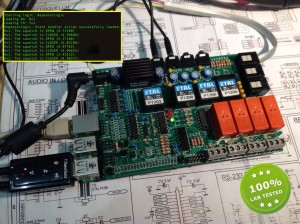- This topic has 5 replies, 2 voices, and was last updated 10 years ago by
Aaron, N3MBH.
-
AuthorPosts
-
November 22, 2015 at 6:17 pm #1463
Aaron, N3MBH
Forum AdministratorHello Justin,
Thanks for following the project. The small board with SMD components that we have previously show a concept of, they were having some issues with the audio chip. That has been delayed for a bit. Juan has finished his large board and testing looks good on that.He just finished that up this week. It uses through hole components. It would require an external USB audio card. I will have to find out the details of how he plans to offer it, kit or fully assembled. More than likely a kit. And the availability. If you are not on the hardware waiting list, please be sure to add yourself as we plan to update folks there.
We are working on the next release of the software which have some improvements. Stay tuned.
Aaron,
N3MBH73,
Aaron – N3MBH / WRFV871OpenRepeater is offered free of charge. Find out how you can support us.
November 23, 2015 at 4:08 am #1464The Interface Board looks good.
I am keen to see full details and feature list.Ho do I add myself to the Hardware Waiting List??
Thanks for you reply
Justin
VK2HJANovember 23, 2015 at 12:50 pm #1465Aaron, N3MBH
Forum AdministratorYou can add your self to the waiting list using the form at the bottom of this blog article.
The main difference in this board vs the other one we are developing for OpenRepeater is that this one has some relay controls on it (the orange components and gray terminal blocks). These would allow for controlling other items at the repeater site via these relays. We would have to write the code for the relays, so at the moment they wouldn’t do anything with OpenRepeater software.
The main thing that is identical to the other board we are working on is the TX, RX, TRX link ports and the audio isolation. As mentioned before, the sound card is an external USB on this board (separate). Both boards also have an integrated voltage regulator to step the voltage down from say 13.8V to the 5 volts required to run the RPI2.
Juan is working on figuring out how and when these will be available. We will update folks via the hardware waiting list first and post a blog article and updates via social media. If for any reason demand is too high initially we will give those on the waiting list priority.
You can also build the basic interface with a EasyDigi which will handle your audio isolation and PTT control. You’d just need to supply a simple COS circuit to isolate the GPIO from the COS from the receiver. We have a general overview of that here.
Hope that helps.
73,
Aaron – N3MBH / WRFV871OpenRepeater is offered free of charge. Find out how you can support us.
November 25, 2015 at 6:42 am #1489Thanks for your reply.
I have a 1RU project under way with a bit of a custom setup but have many good ideas I am keen to adapt as time moves on.Thanks again
Justin
VK2HJANovember 27, 2015 at 12:08 pm #1490Aaron, N3MBH
Forum AdministratorNot a problem. Glad to help. Stay tune, we hope to announce the next software release in the near future.
73,
Aaron – N3MBH / WRFV871OpenRepeater is offered free of charge. Find out how you can support us.
-
AuthorPosts
- The forum ‘Hardware’ is closed to new topics and replies.

